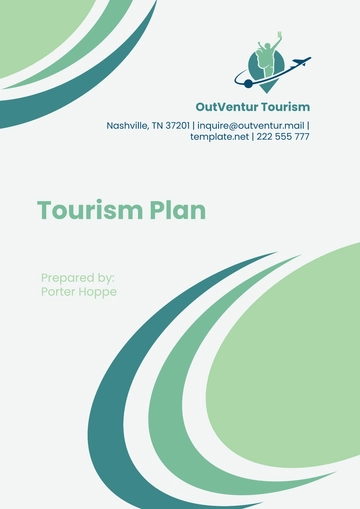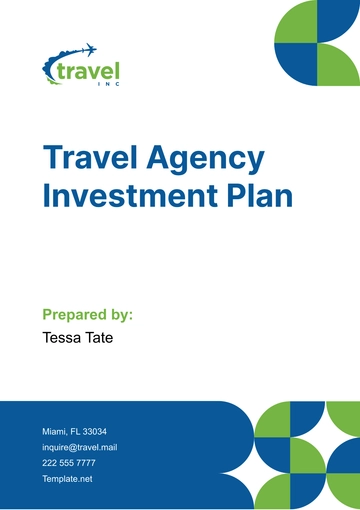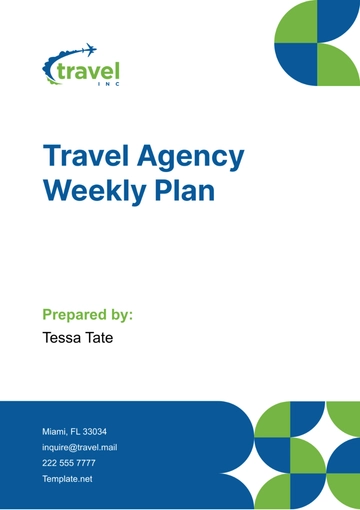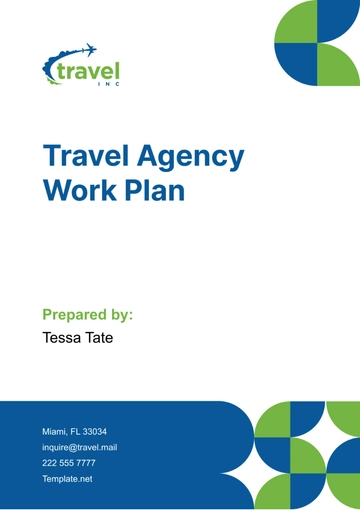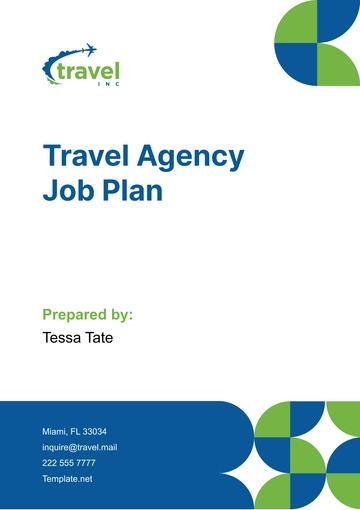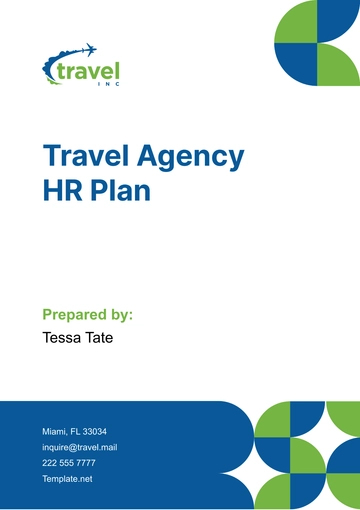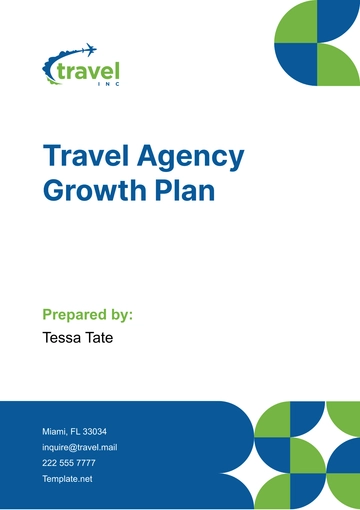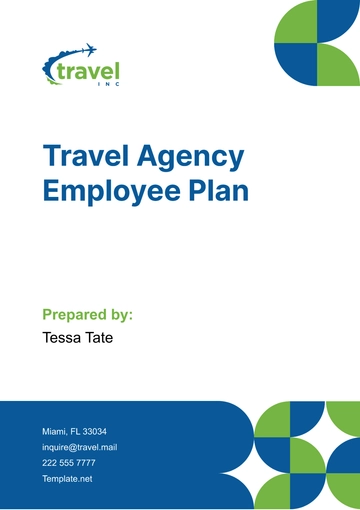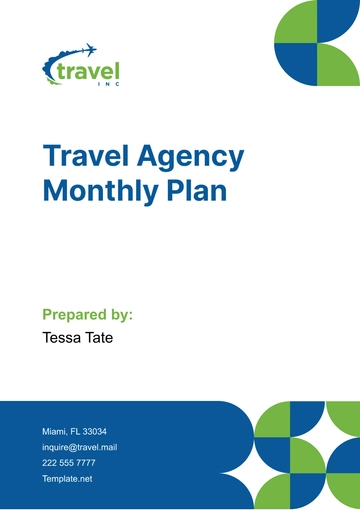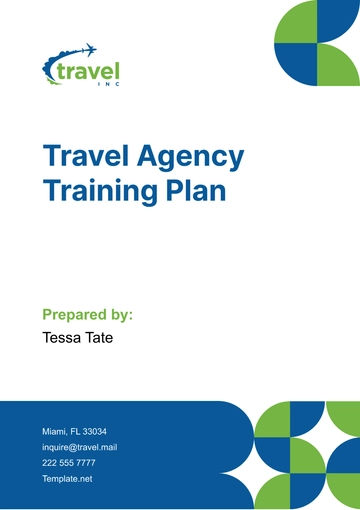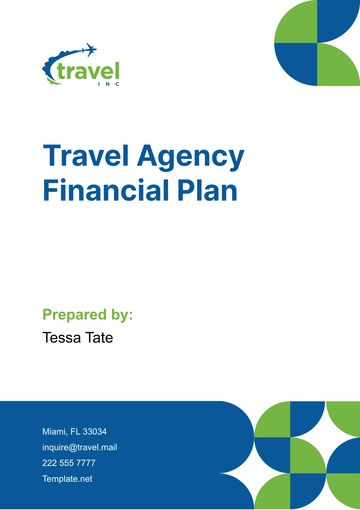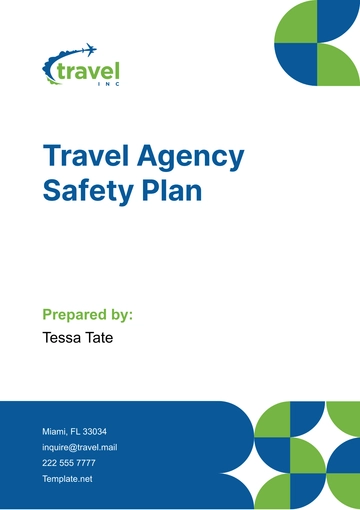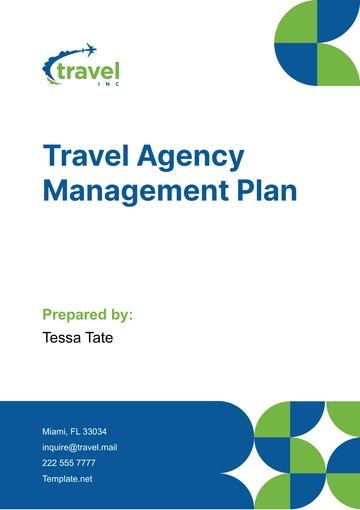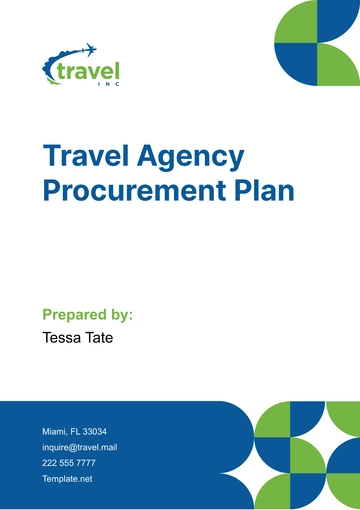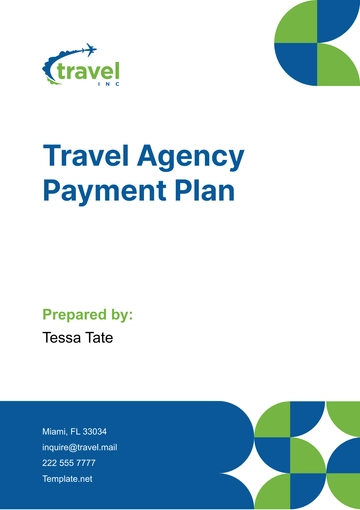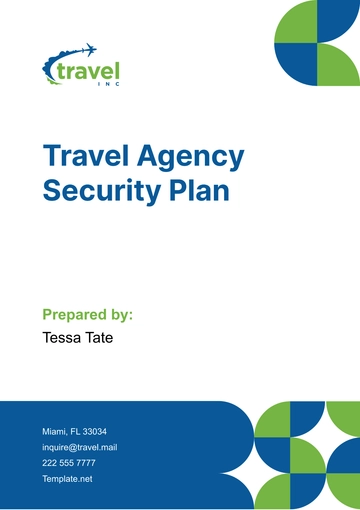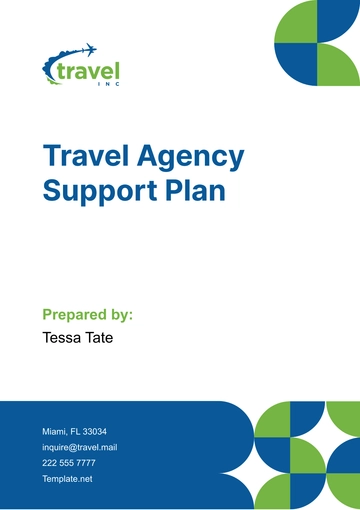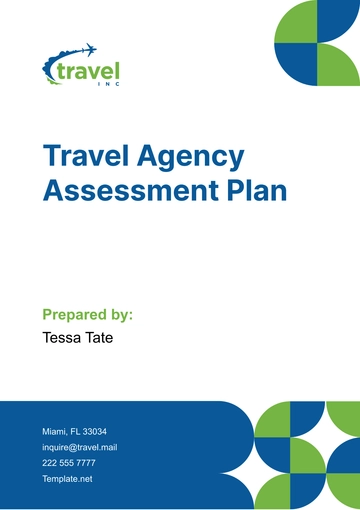Free Travel Agency Assessment Plan

A. Introduction
This Travel Agency Assessment Plan is designed to comprehensively evaluate and enhance the operational effectiveness and service quality of [Your Company Name]. In an ever-evolving travel industry landscape, it is imperative for travel agencies to continually refine their operations to meet the changing needs and expectations of customers. This plan takes a holistic approach, considering various facets of the agency's operations, including service quality, market positioning, competitive analysis, technological integration, and financial management.
With a focus on optimizing performance and enhancing customer satisfaction, the assessment plan aims to identify strengths, weaknesses, opportunities, and threats within the agency's operations. By implementing strategic improvements based on the findings of this assessment, [Your Company Name] will be better positioned to thrive in the competitive travel market while ensuring compliance with relevant US laws and standards.
B. Objective Definition
This section outlines the primary objectives of the Travel Agency Assessment Plan, aimed at driving strategic improvements and enhancing overall performance. These objectives serve as guiding principles for the assessment process, aligning with the agency's overarching goals and strategic priorities:
Enhance Customer Service: Improve customer satisfaction levels by providing personalized and efficient service throughout the travel experience.
Improve Operational Efficiency: Streamline internal processes and workflows to enhance productivity and reduce operational costs.
Expand Market Reach: Identify and capitalize on opportunities to target new customer segments and enter emerging markets, both domestically and internationally.
The successful execution of these objectives is expected to position [Your Company Name] competitively within the global travel industry, ensuring sustained growth and profitability.
C. Scope of Assessment
The scope of this assessment is comprehensive, covering all key functional areas of [Your Company Name]'s operations. It includes but is not limited to customer service, marketing strategies, information technology (IT) systems, operational processes, and financial management practices. By evaluating each of these areas, the assessment aims to provide a holistic view of the agency's performance and identify opportunities for improvement.
In addition to internal factors, the assessment plan will also consider external influences such as market trends, competitive landscape, regulatory requirements, and technological advancements impacting the travel industry. By analyzing both internal and external factors, [Your Travel Agency Name] can gain valuable insights into industry dynamics and position itself strategically to capitalize on emerging opportunities and mitigate potential threats.
D. Market Positioning Assessment
This section of the assessment plan focuses on analyzing [Your Company Name]'s current market position relative to competitors. Through a comprehensive evaluation of branding, unique selling propositions (USPs), and market share, strengths, weaknesses, opportunities, and threats (SWOT) will be identified. The insights gathered from this analysis will inform strategic adjustments to enhance [Your Company Name]'s competitive positioning within the travel industry.
Aspects Evaluated | Description |
|---|---|
Branding | Evaluate the strength and consistency of [Your Company Name]'s brand identity and perception in the market. |
Unique Selling Propositions (USPs) | Identify and assess the unique features or services offered by [Your Company Name] that differentiate it from competitors. |
Market Share | Analyze [Your Company Name]'s market share compared to key competitors within the travel industry. |
Strengths | Identify internal factors and assets that contribute to [Your Company Name]'s competitive advantage in the market. |
Weaknesses | Assess internal limitations or deficiencies that may hinder [Your Company Name]'s ability to compete effectively. |
Opportunities | Explore external factors or market trends that [Your Company Name] can leverage to gain a competitive edge. |
Threats | Identify external challenges or risks that may pose a threat to [Your Company Name]'s market position and sustainability. |
E. Service Quality Evaluation
This section of the assessment plan emphasizes the systematic collection and analysis of client feedback to assess service satisfaction levels. Through an in-depth evaluation of various service aspects, [Your Company Name] aims to ensure high-quality service delivery and enhance the overall customer experience.
1. Feedback Collection Process
Client feedback will be collected through multiple channels, including online surveys, feedback forms, and direct communication channels such as emails or phone calls. [Your Company Name] will implement a structured feedback collection process to gather insights into various aspects of service quality.
2. Evaluation Criteria
The evaluation will focus on the following key criteria:
Response Times: Measure the speed and efficiency of [Your Company Name]'s response to client inquiries, requests, and concerns.
Employee Courtesy: Assess the professionalism, friendliness, and helpfulness exhibited by [Your Company Name]'s staff during interactions with clients.
Customization of Travel Packages: Evaluate [Your Company Name]'s ability to tailor travel packages to meet the specific needs and preferences of clients.
Problem Resolution Effectiveness: Determine the effectiveness and timeliness of [Your Company Name]'s response in addressing and resolving client issues or complaints.
3. Analysis and Insights
Client feedback will be systematically analyzed to identify trends, patterns, and areas for improvement. Insights gathered from the evaluation will provide valuable input for developing training programs and implementing service enhancement initiatives aimed at addressing any identified shortcomings and further elevating the quality of service delivery.
F. Technological Advancements
Assessing the technological landscape of [Your Company Name], this section delves into the agency's current technology stack, exploring integration levels and automation efficiencies. Additionally, it provides strategic recommendations for adopting cutting-edge technologies to augment service quality and operational efficacy.
1. Technology Stack Review
The existing technology infrastructure, including software applications, databases, and communication systems, will be evaluated to determine its effectiveness in supporting the agency's operations. This review will assess factors such as scalability, compatibility, and ease of use.
2. Integration and Automation Assessment
The level of integration and automation across various systems and processes will be analyzed to identify opportunities for streamlining workflows and reducing manual tasks. This assessment will focus on areas such as booking management, payment processing, and communication with clients.
3. Recommendations for New Technologies
Based on the findings of the review and assessment, recommendations will be made for adopting new technologies to enhance [Your Company Name]'s capabilities. This may include:
AI for Personalized Travel Suggestions: Implementing artificial intelligence (AI) solutions to analyze customer preferences and behavior data, enabling the provision of personalized travel suggestions and recommendations.
Blockchain for Secure Transactions: Exploring the integration of blockchain technology to ensure secure and transparent transactions, particularly for payment processing and data management.
4. Implementation Plan
A detailed plan for implementing the recommended technologies will be developed, outlining timelines, resource requirements, and potential challenges. This plan will consider factors such as budget constraints, training needs, and stakeholder involvement to ensure a smooth transition to new systems and processes.
G. Financial Review
In navigating the complex terrain of the travel industry, [Your Company Name] recognizes the paramount importance of financial acumen. This section embarks on a comprehensive examination of the agency's financial landscape, a cornerstone in fortifying its position as a leader in the industry.
1. Financial Health Assessment
Anchored in meticulous data analysis, this assessment provides a panoramic view of [Your Company Name]'s financial health. By scrutinizing key metrics spanning profitability, liquidity, and solvency, including in-depth analysis of income statements, balance sheets, and cash flow statements, the agency gains invaluable insights into its financial standing.
2. Profitability Analysis
At the heart of sustainable growth lies profitability. Through a granular analysis of revenue streams, cost structures, and profit margins, [Your Company Name] identifies opportunities for optimization, steering towards enhanced financial performance and long-term viability.
3. Cash Flow Management
In the dynamic landscape of the travel industry, cash flow reigns supreme. This segment delves into the intricacies of cash flow forecasting, working capital management, and ongoing monitoring, ensuring robust liquidity and financial resilience.
4. Expense Management Review
Efficient expense management is a linchpin in operational excellence. By dissecting expenditure patterns, identifying cost-saving opportunities, and implementing stringent controls, [Your Company Name] charts a course towards optimized resource utilization and sustainable growth.
5. Establishment of Financial KPIs
Guided by a commitment to excellence, [Your Company Name] sets the stage for success through the establishment of robust financial KPIs. These benchmarks serve as beacons, guiding the agency's financial journey and propelling it towards its strategic objectives with clarity and purpose.
H. Competitive Analysis
In this crucial phase, [Your Company Name] embarks on a comprehensive examination of its key competitors, gathering valuable insights to establish a competitive benchmark. Through meticulous data collection and analysis, the agency seeks to understand and benchmark factors such as pricing strategies, customer loyalty programs, and service innovation initiatives. This strategic approach enables [Your Company Name] to formulate informed strategies aimed at maintaining a competitive edge in the dynamic travel industry landscape.
Data Collection: Gather information on key competitors in the travel industry, including both direct competitors and emerging players.
Pricing Strategies: Analyze competitors' pricing models, including pricing tiers, discounts, and promotional offers, to identify competitive pricing strategies.
Customer Loyalty Programs: Evaluate competitors' loyalty programs and incentives aimed at retaining customers and fostering brand loyalty.
Service Innovation: Assess competitors' efforts in service innovation, such as new technologies, unique offerings, and personalized customer experiences, to identify areas for differentiation and improvement.
I. Customer Engagement Strategies
In a rapidly evolving landscape, [Your Company Name] recognizes the pivotal role of customer engagement in fostering lasting relationships and driving business growth. This section outlines the agency's commitment to devising innovative customer engagement strategies that seamlessly blend digital interaction with physical engagement to create an unparalleled omnichannel experience.
1. Digital Interaction Enhancement
In an era dominated by digital connectivity, [Your Company Name] prioritizes enhancing its online presence and engagement. Through targeted social media campaigns, interactive content creation, and personalized messaging, the agency aims to foster meaningful connections with customers across various digital platforms. By leveraging social media analytics and customer feedback, [Your Company Name] continually refines its digital engagement strategies to ensure relevance and effectiveness.
2. Physical Engagement Enrichment
While digital channels offer unprecedented reach, [Your Company Name] understands the value of physical interactions in building trust and rapport with customers. The agency organizes engaging events, workshops, and promotions, providing opportunities for face-to-face interactions and immersive brand experiences. Through experiential marketing initiatives and community engagement efforts, [Your Company Name] creates memorable moments that resonate with customers, fostering loyalty and advocacy.
3. Seamless Omnichannel Experience
At the heart of [Your Company Name]'s customer engagement strategy lies the commitment to delivering a seamless omnichannel experience. By integrating digital and physical touchpoints cohesively, the agency ensures consistency and continuity throughout the customer journey. Whether online or offline, customers experience a unified brand presence, with seamless transitions between channels and personalized interactions tailored to their preferences and needs.
J. Operational Efficiency
In pursuit of operational excellence, [Your Company Name] commits to leveraging process mapping techniques to identify and address bottlenecks and inefficiencies within its operations. Through strategic improvement tactics such as staff training, outsourcing non-core activities, and adopting lean management principles, the agency aims to streamline workflows and enhance overall efficiency.
1. Process Mapping for Operational Analysis
Data Collection ↓ Process Identification ↓ Bottleneck Identification |
Data Collection: Gather information on existing processes and workflows across all departments within the agency.
Process Identification: Identify key operational processes and map out each step from initiation to completion.
Bottleneck Identification: Analyze process maps to pinpoint areas of congestion, delays, or redundancies that hinder efficiency.
2. Improvement Tactics Implementation
Staff Training: Provide targeted training programs to equip employees with the skills and knowledge necessary to perform their roles efficiently.
Outsourcing Non-Core Activities: Identify non-core activities that can be outsourced to specialized third-party vendors to free up internal resources and focus on core business functions.
Adopting Lean Management Principles: Introduce lean management principles to eliminate waste, optimize resource allocation, and streamline workflows for maximum efficiency.
K. Action Plan and Timeline
With a focus on driving actionable outcomes, the Action Plan and Timeline section lays out a structured roadmap for [Your Company Name]'s strategic initiatives. By delineating clear action items and timelines, the agency is poised to implement targeted interventions and drive meaningful progress towards operational excellence and customer satisfaction.
Phase | Action Item | Responsible | Deadline |
|---|---|---|---|
Q1 | Market Positioning Review | Marketing Team | March 31 |
Q2 | Upgrade Technology Platforms | IT Department | June 30 |
Q3 | Implement Customer Feedback Tool | Customer Service Team | September 30 |
Q4 | Financial Systems Overhaul | Finance Team | December 31 |
Q1 Next Year | Launch New Marketing Campaign | Marketing Team | March 31 |
L. Monitoring and Evaluation
In a dynamic industry landscape, continuous monitoring and evaluation are imperative to track progress and ensure alignment with strategic objectives. This section outlines [Your Company Name]'s commitment to ongoing assessment through quarterly reviews and data collection. By leveraging key performance indicators (KPIs) and relevant metrics, the agency will gauge its performance against set objectives, enabling timely adjustments to the plan to stay on the strategic path.
1. Continuous Monitoring Process
Quarterly Reviews: At the end of each quarter, [Your Company Name] will conduct comprehensive reviews to assess progress towards set objectives. These reviews will involve a thorough examination of performance metrics, including financial indicators, customer satisfaction scores, and operational efficiency measures.
Data Collection: Relevant data will be systematically collected and analyzed to provide insights into the agency's performance across various areas. This includes data on customer feedback, market trends, competitor analysis, and financial reports.
2. Adjustments and Course Corrections
Based on the findings from monitoring and evaluation activities, [Your Company Name] will make necessary adjustments to the plan to address any deviations from set objectives. This may involve reallocating resources, refining strategies, or implementing corrective measures to ensure the agency remains on track towards its goals.
M. Conclusion
In concluding this assessment and strategic plan, [Your Company Name] is poised to achieve significant advancements in market positioning, operational efficiency, and customer experience. Through a commitment to adaptability and innovation, the agency is primed for continued growth and success in the competitive travel industry landscape.
Strengthening Market Position
Enhancing Operational Efficiency
Ensuring Superior Customer Experience
With these strategic imperatives at its core, [Your Company Name] is well-positioned to thrive in an ever-evolving market.
- 100% Customizable, free editor
- Access 1 Million+ Templates, photo’s & graphics
- Download or share as a template
- Click and replace photos, graphics, text, backgrounds
- Resize, crop, AI write & more
- Access advanced editor
Evaluate and optimize performance with Template.net's Travel Agency Assessment Plan Template. This customizable and editable document simplifies the creation of assessment plans for your agency's operations and services. Tailored for the travel industry, it ensures thorough evaluation and continuous improvement. Editable in our Ai Editor Tool, it facilitates seamless customization to meet your assessment needs.
You may also like
- Finance Plan
- Construction Plan
- Sales Plan
- Development Plan
- Career Plan
- Budget Plan
- HR Plan
- Education Plan
- Transition Plan
- Work Plan
- Training Plan
- Communication Plan
- Operation Plan
- Health And Safety Plan
- Strategy Plan
- Professional Development Plan
- Advertising Plan
- Risk Management Plan
- Restaurant Plan
- School Plan
- Nursing Home Patient Care Plan
- Nursing Care Plan
- Plan Event
- Startup Plan
- Social Media Plan
- Staffing Plan
- Annual Plan
- Content Plan
- Payment Plan
- Implementation Plan
- Hotel Plan
- Workout Plan
- Accounting Plan
- Campaign Plan
- Essay Plan
- 30 60 90 Day Plan
- Research Plan
- Recruitment Plan
- 90 Day Plan
- Quarterly Plan
- Emergency Plan
- 5 Year Plan
- Gym Plan
- Personal Plan
- IT and Software Plan
- Treatment Plan
- Real Estate Plan
- Law Firm Plan
- Healthcare Plan
- Improvement Plan
- Media Plan
- 5 Year Business Plan
- Learning Plan
- Marketing Campaign Plan
- Travel Agency Plan
- Cleaning Services Plan
- Interior Design Plan
- Performance Plan
- PR Plan
- Birth Plan
- Life Plan
- SEO Plan
- Disaster Recovery Plan
- Continuity Plan
- Launch Plan
- Legal Plan
- Behavior Plan
- Performance Improvement Plan
- Salon Plan
- Security Plan
- Security Management Plan
- Employee Development Plan
- Quality Plan
- Service Improvement Plan
- Growth Plan
- Incident Response Plan
- Basketball Plan
- Emergency Action Plan
- Product Launch Plan
- Spa Plan
- Employee Training Plan
- Data Analysis Plan
- Employee Action Plan
- Territory Plan
- Audit Plan
- Classroom Plan
- Activity Plan
- Parenting Plan
- Care Plan
- Project Execution Plan
- Exercise Plan
- Internship Plan
- Software Development Plan
- Continuous Improvement Plan
- Leave Plan
- 90 Day Sales Plan
- Advertising Agency Plan
- Employee Transition Plan
- Smart Action Plan
- Workplace Safety Plan
- Behavior Change Plan
- Contingency Plan
- Continuity of Operations Plan
- Health Plan
- Quality Control Plan
- Self Plan
- Sports Development Plan
- Change Management Plan
- Ecommerce Plan
- Personal Financial Plan
- Process Improvement Plan
- 30-60-90 Day Sales Plan
- Crisis Management Plan
- Engagement Plan
- Execution Plan
- Pandemic Plan
- Quality Assurance Plan
- Service Continuity Plan
- Agile Project Plan
- Fundraising Plan
- Job Transition Plan
- Asset Maintenance Plan
- Maintenance Plan
- Software Test Plan
- Staff Training and Development Plan
- 3 Year Plan
- Brand Activation Plan
- Release Plan
- Resource Plan
- Risk Mitigation Plan
- Teacher Plan
- 30 60 90 Day Plan for New Manager
- Food Safety Plan
- Food Truck Plan
- Hiring Plan
- Quality Management Plan
- Wellness Plan
- Behavior Intervention Plan
- Bonus Plan
- Investment Plan
- Maternity Leave Plan
- Pandemic Response Plan
- Succession Planning
- Coaching Plan
- Configuration Management Plan
- Remote Work Plan
- Self Care Plan
- Teaching Plan
- 100-Day Plan
- HACCP Plan
- Student Plan
- Sustainability Plan
- 30 60 90 Day Plan for Interview
- Access Plan
- Site Specific Safety Plan
